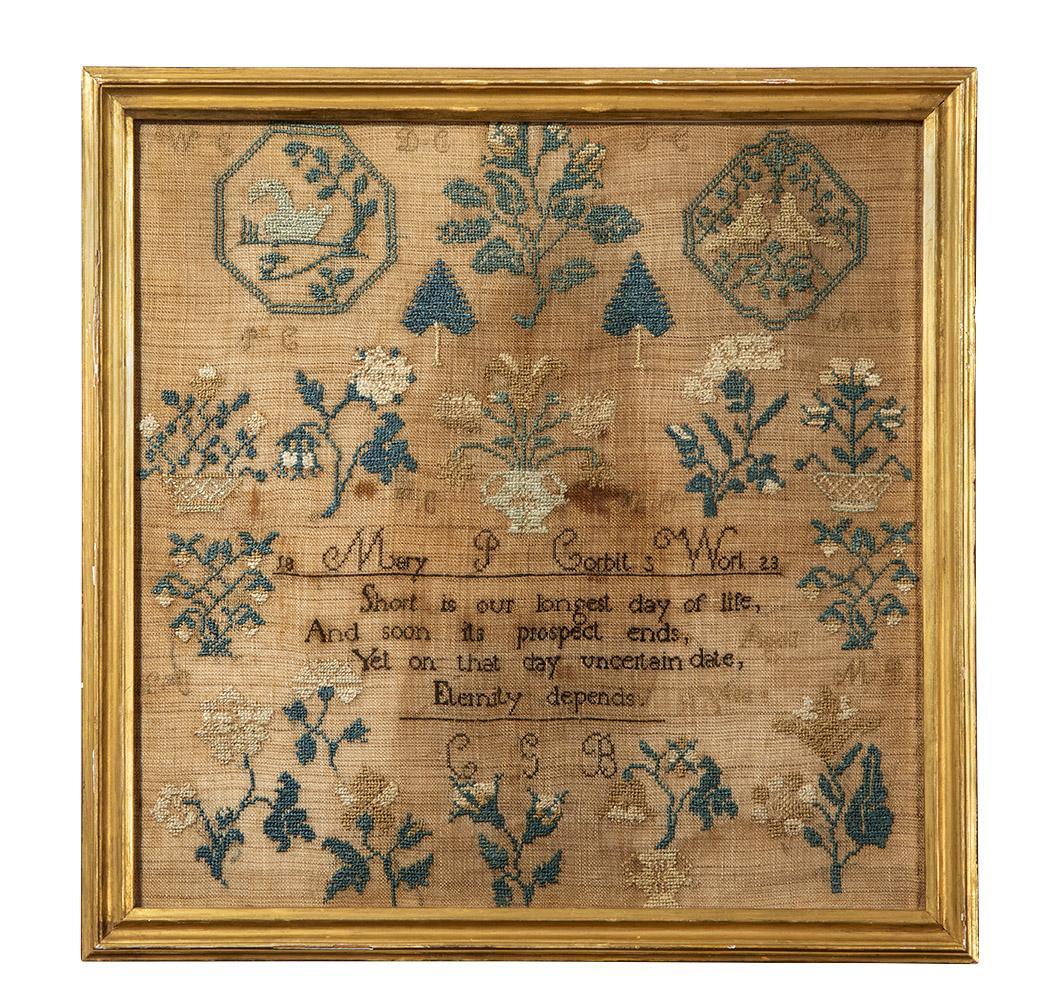Needlework sampler
Odessa, Delaware
1823
Maker
Mary Pennell Corbit (1812-1875)
Measurements
15-5/8 in x 15-3/4 in (sight)
Materials
Silk on linen
Credit Line
Historic Odessa Foundation, The David Wilson Mansion, Inc.
Accession Number
1971.1525
Inscription
“Mary P Corbit s Work 23 / Short is our longest day of life, / And soon its prospect ends, / Yet on that day uncertain date, / Eternity depends. / C. G. B.” is stitched into a text block in the lower center of the sampler, and ten paired initials–WC, DC, SC, MC, PC, MC, JC, MO, LC, MB–appear symmetrically throughout the sampler.
Condition Notes
Large areas of staining discolor the linen, and yellow dyes appear to have faded.
Provenance
Although no written provenance remains, the sampler likely descended from Mary, the maker, to one of her two daughters, Mary Cornelia (b. 1835) or Clara Jones (1838–1880). Only Clara had descendants, through which the portrait of Mary was given. Unmarried Mary may have given the sampler to Mary Corbit Warner for the David Wilson Mansion.
Comments
This sampler was made at the same time as Mary’s sister Sarah made hers (acc. no. 1977.222). At the time, each child (aged 10 and 12, respectively) was orphaned and under the charge of her uncle Daniel Corbit. His account book records “2 quarters tuition” paid to “C. Bradford,” who was Catharine Golden Bradford (c. 1799–c. 1880) and “1 Silver thimble [bought] at Smyrna” for each girl to cover some of their schooling expenses. He also paid for a “gilt frame for sampler” under headings for each child. (See “Daniel Corbit account book, Cantwell’s Bridge,” acc. no. 1959.4041, entries dated Apr. 14, 1823, p. 156.)
The samplers incorporate motifs of long-standing popularity among Quakers. In addition to floral sprigs, they have paired love birds within geometric devices and a popular religious verse. Mary’s came from published school book texts, whereas Sarah’s drew from a hymn in Isaac Watts’s ubiquitous Hymns and Spiritual Songs. Ten paired initials, stitched in now-muted colors, occur symmetrically across the sampler. Although Delaware samplers often incorporated paired initials, whose identity often confounds the modern viewer, the two samplers use identical paired letters in nearly identical placements. The top row of four pairs and the two in the next level represent paternal grandparents, uncle and aunt, and parents. Identities of the lower two levels are more puzzling. Family surnames included Corbit, Clark, and Cowgill, which may address two paired initials, but MO and MB remain unresolved.
Bibliography
Susan Burrows Swan, A Winterthur Guide to American Needlework (New York: Crown, 1976), 16.
Gloria Seaman Allen and Cynthia Shank Steinhoff, Delaware Discoveries: Girlhood Embroidery, 1750–1850(Baltimore, Md.: Chesapeake Book Co. for the Biggs Museum of American Art, 2019), 289.
Zimmerman, A Storied Past, 183-184.
